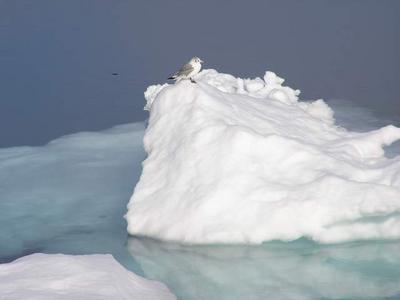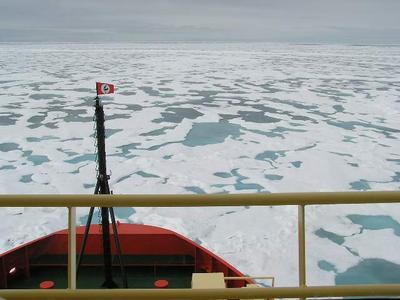16 July, 2003
Let's have Jim Swift do the talking for today:
Chief Scientist's Report #2
R/V Nathaniel B. Palmer SBI Survey Cruise
16 July 2003
James H. Swift
16 July 2003, ca. 1:00 pm Alaska time - from R/V Nathaniel B. Palmer
in the Beaufort Sea
We have been busy with the routine business of carrying out a survey
at sea. We arrived off Nome two and one half days after leaving Dutch
Harbor, and spent much of one day with business regarding the
helicopter, which was based in Nome. The pilot did practice landings,
and then flew out spare parts. We headed to Bering Strait where we
started our science work and picked up Chuck Menadelook, an Alaskan
native who lives on Little Diomede island. The weather was below
flying minimum so some of Chuck's friends brought him out to the
Palmer in a small boat. Chuck is very interested in everything going
on and is both having a good time and contributing solidly to our
work, having joined the midnight-to-noon watch. We were supposed to
set him off at Barrow after five days but it wasn't convenient to do
so at the time and thus he is still aboard.
On our trek north we stopped for some stations but generally steamed.
On July 12th we started our first section of measurements northeast
of Barrow, across the Alaskan continental slope and into the Arctic
Ocean interior. Yesterday afternoon we finished our 37th station,
completing that section. Our stations were only 3 miles apart for
much of the section, which provides a finely detailed, coherent view
of the variations across the shelf and continental slope. The
preliminary data look to be interesting for the goals of the program.
The three graduate students we have along are very helpful. They
picked up on the CTD operations right away and, along with Eric
Johnson (the LADCP specialist), do an excellent job of running the
stations.
All in the science team are doing well and working well together.
There are only the usual little problems with the equipment. Data
quality has been excellent. As I thought before the cruise, the
station work comes too quickly for the analysts to keep up so we take
a few hours off from casts every day. This 'time off' was built into
the plan.
We saw evidence of 'spring' biological activity over the edge of the
continental shelf, but the deep basin appears to be a biological
desert, with very little algae on the underside of the ice, for
example. (We get a good view of the underside of the ice as it is
turned over during icebreaking.) Ice conditions are much lighter than
initially forecast (the forecasts were based on data from years ago).
Captain Joe and his officers are having no parcticular problems taking
the Palmer through the ice.
We have seen several polar bears, though usually at quite a distance.
On the way north we saw many walruses, and we see seals frequently.
The marine mammal group has had only one science to date because of
fog and icing conditions.
Weather and sea conditions have been calm. The air temperature
dropped below zero as we headed northward across the continental
shelf slope. The ice cover is loose and mostly rotten first year ice
with remnants of small ridges. Life and science on board goes well.

An immature Black-legged Kittiwake visits the Palmer.

Seascape from the Palmer's bridge.

The Palmer passes by a Ringed Seal on the port side.
Contact the TEA in the field at
.
If you cannot connect through your browser, copy the
TEA's e-mail address in the "To:" line of
your favorite e-mail package.
|
